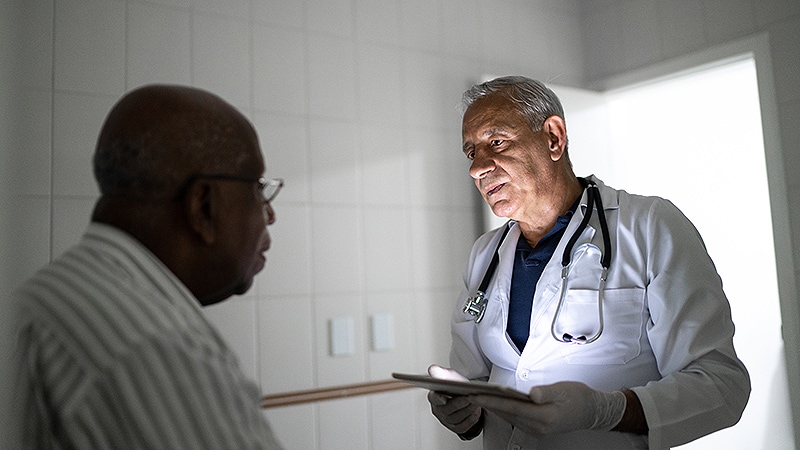Key takeaways:
- Subclinical left ventricular abnormalities in SSc impact survival and increase dyspnea risk.
- LV ejection fraction may not be sensitive enough to pick up clinically important dysfunction.
Patients with systemic sclerosis who demonstrate left ventricular abnormalities, either overt or “subclinical,” have poorer survival and increased shortness of breath, according to data published in Seminars in Arthritis and Rheumatism.
The subclinical abnormalities were assessed via an advanced measure of subtle left ventricular systolic dysfunction — LV global longitudinal strain (LV-GLS) — suggesting that a less advanced measure — LV ejection fraction (LV-EF) — may not be sensitive enough to pick up clinically important cardiac dysfunction among patients with SSc, the researchers added.

“We had observed anecdotally that systolic left ventricular dysfunction was uncommon in the Australian Scleroderma Cohort Study, although other work by our group and others had described that diastolic dysfunction occurs in around 20% to 30% of SSc cohorts,” lead author Jessica L. Fairley, MD, MPH, of the department of rheumatology at St. Vincent’s Hospital, in Melbourne, Australia, told Healio.
“Accordingly, we sought to explore the frequency of LV systolic dysfunction in our cohort and explore the correlates of this,” she added. “Of particular interest was the frequency of subtle, ‘pre-clinical’ systolic abnormalities, including LV-GLS, and whether these could predict overt LV dysfunction.”
To that end, Fairley and colleagues analyzed data from 1,141 patients with SSc recruited into the Australian Scleroderma Cohort Study between 2007 and August 2022 who had at least one LVEF measurement. Patients with secondary causes of LV function unrelated to SSc, such as myocardial ischemia and pulmonary arterial hypertension, were excluded.
Overt LV dysfunction was defined as an LV-EF less than 50%, while subclinical LV dysfunction was defined as LV-GLS readings higher than –16%. Between-group comparisons were made using Chi-squared tests, two-sample t-tests and Wilcoxon rank-sum tests, while survival analysis was conducted using Kaplan-Meier and Cox proportional hazard models.
During follow-up, 2.4% of patients recorded an LV-EF of less than 50%, while 0.6% recorded an LV-EF of 40% or lower. According to the researchers, overt LV dysfunction was linked to increased risk for WHO class III/IV dyspnea (OR = 3.5; 95% CI, 1.6-7.7), shorter 6-minute walk distance (P = .01), higher scores on the Health Assessment Questionnaire-Disability Index (P < .01), and lower scores on the Short Form-36 Physical Component Summary (P = .02).
“Overt LV dysfunction in SSc occurs infrequently but portends a poor prognosis,” Fairley said. “Even though it is transient in the majority of cases, it was strongly associated with poorer survival, health-related quality of life and severe SSc features. Accordingly, these patients should be closely monitored for other organ involvement, particularly renal and skeletal muscle disease.”
At the one center where LV-GLS data were available, 44 of 211 patients with normal LV-EF demonstrated impaired LV-GLS, which was “suggestive of subclinical LV systolic dysfunction,” the researchers wrote. LV-GLS impairment was linked to poorer survival in a univariable analysis (HR = 3.4; 95% CI, 1-11.8), but significance lessened after adjusting for age (HR = 2.7; 95% CI, 0.8-9.5). There was also an increased risk for dyspnea after adjusting for age and sex in a generalized estimating equation model (OR = 3.6; 95% CI, 1.4-9.2), according to the researchers.
“A similar pattern has been seen in cohorts with inflammatory myopathies, where overt LV dysfunction is uncommon, but more subtle changes are surprisingly frequent,” Fairley said. “Moreover, although we had only small numbers with LV-GLS data, as these aren’t routinely recorded in our cohort, we found an association with poorer survival and increased dyspnea.
“This means that these abnormalities aren’t really ‘subclinical,’ as we’ve been saying to date — they are associated with adverse outcomes for patients,” she added.
Asked about future research, Fairley noted this study had “insufficient longitudinal LV-GLS data to examine whether abnormal LV-GLS can portend reduced LV-EF over time.”
“Furthermore, exploring more longitudinal data about subtle measures of systolic dysfunction to understand more about their trajectory and impact would be hugely useful,” she said.










